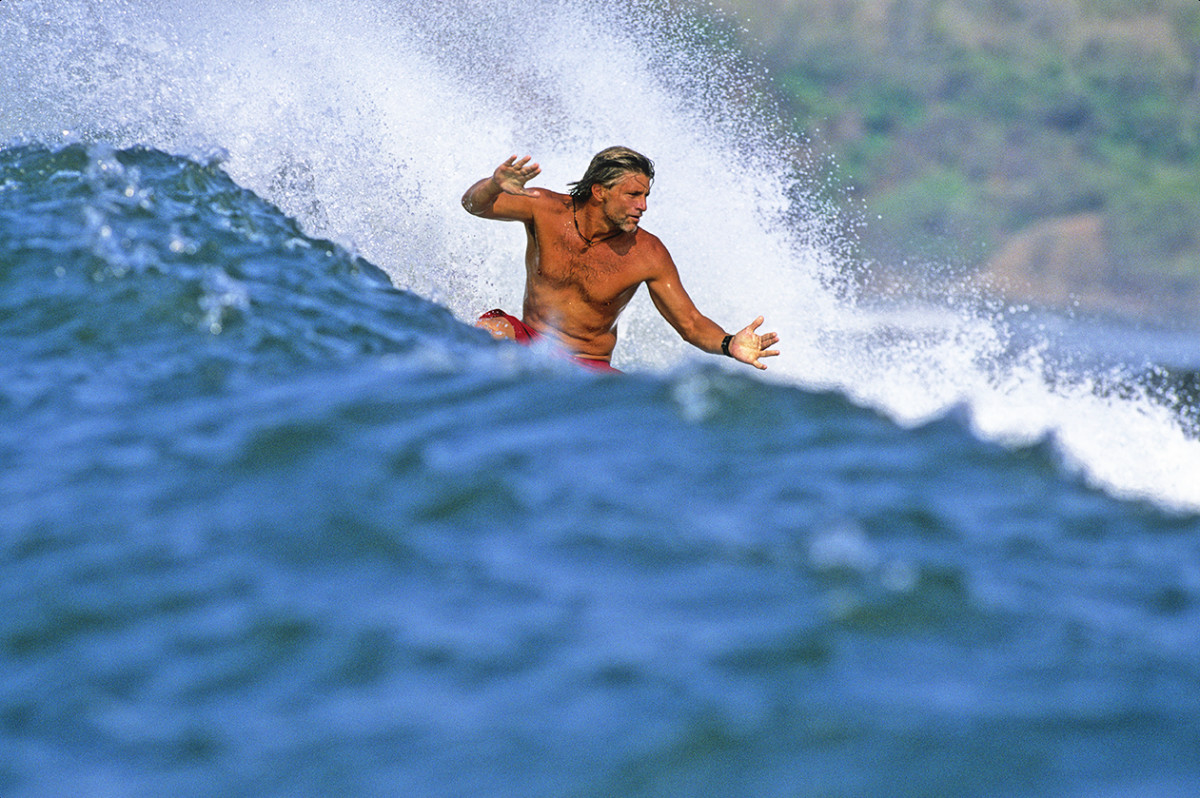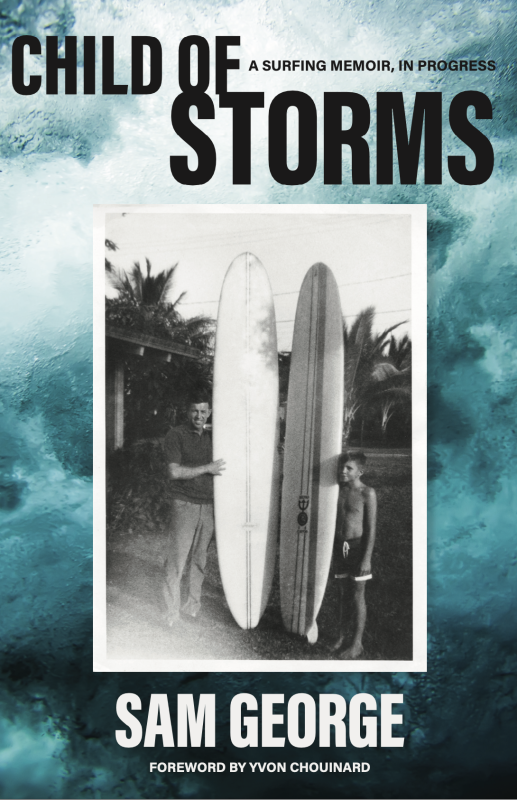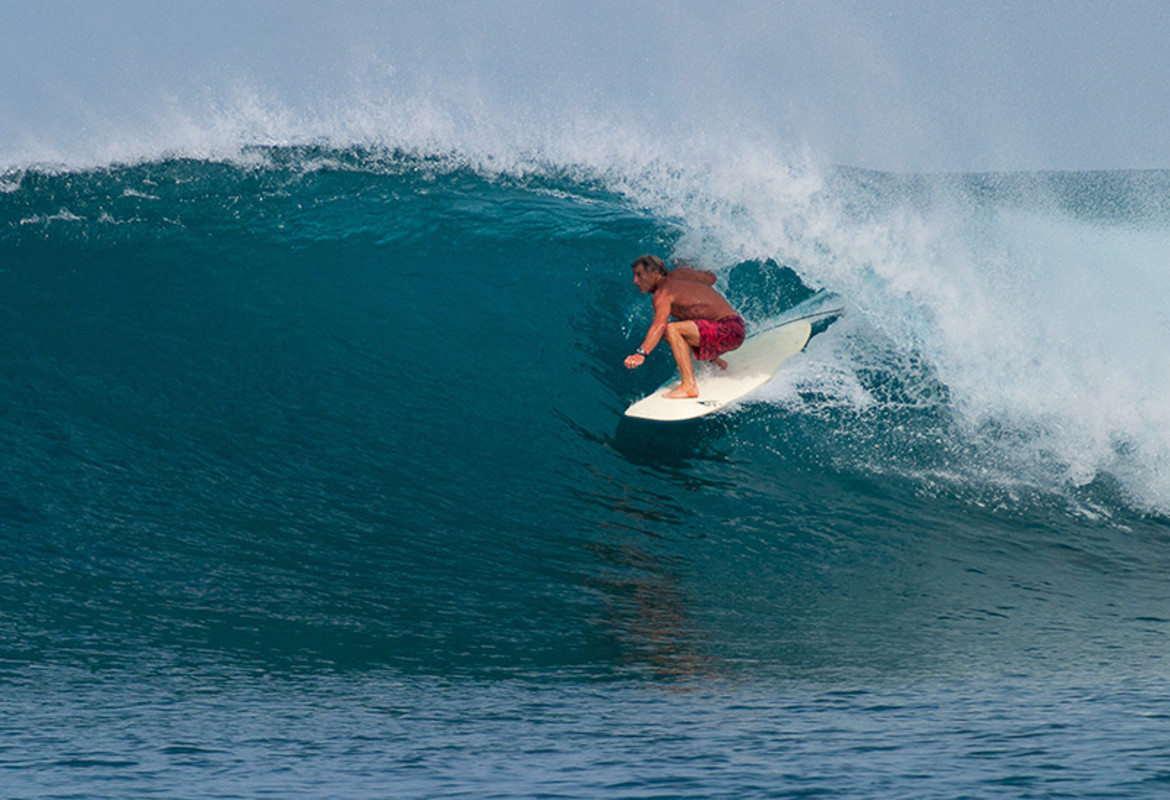It’s a fair wager that few people have spent as much time thinking of, obsessing over, focusing on and writing about surfing and all it encompasses as Sam George. Born in 1956, George found surfing as a kid in 1967 after bouncing from France to California’s Imperial Valley to Hawaii. After a stint as a professional surfer in his 20s, George became a contributing editor at Surfing Magazine (1985-1992) and then Editor-in-Chief at SURFER Magazine (1999-2005).
George didn’t limit his love of surfing to the print medium. He won an Emmy Award for his 2014 documentary, Hawaiian: The Legend of Eddie Aikau, which aired on ESPN’s “30 for 30” series. He worked with skateboard legend Stacy Peralta on several films, including Riding Giants, Bones Brigade, and The Yin and Yang of Gerry Lopez. In 2010, he wrote and directed Hollywood Don’t Surf, which premiered at the prestigious Cannes Film Festival.

Jeff Divine
But in his coverage of the culture, George has not been an idle passenger. He is fully immersed, retaining that curiosity, commitment and enthusiasm for surfing. He has prioritized surfing, using it as a medium to travel the world, explore unsurfed waves and meet fascinating people. By his count, he has ridden 695 surf spots in 42 countries. Some wave you’ve heard of. Others, you never will. In 2000, he, Randy Rarick and John Callahan encountered a uniquely indigenous surf community on a small African island so small and remote a cartographer would have trouble pinning it on a map. Sam George has lived a surf life.
This is a guy who, as a child, would stay nose deep in a copy of SURFER while in the backseat of his mother’s car when she drove intoxicated through Newark, Ohio. He’s been surfing less than a year, but already he was prepared to die a surfer. “But I would crouch there, fingers in my ears, staring at the page, so that if at any second I was killed, my very last image would be one of surfing,” George wrote.

Di Angelo Publications
Though he’s published six surf books, the passage above comes from a new and more personal work. “Child of Storms: A Surfing Memoir In Progress”, available now from Di Angelo Publications, is more than a series of profiles and travelogues. It’s the story of George and his most memorable and formative experiences since he began surfing 58 years ago. There are personal accounts, lessons learned, and formative moments shared. It’s a memoir, after all, with an ever-present throughline. “It’s a surfing life,” George said. “It’s not necessarily about surfing.”
A surfer, George has chops. He’s rubbed shoulders with the greats in pro contests from 1979 to 1985. He’s close with the living legends of surf culture. He knows the nuances involved with maneuvering a surfboard. But he knows that describing the technical jargon of surfing’s physical characteristics is usually not the most compelling thing for most readers. So he takes a different tack—and uncovers the bones that are the foundation of good stories.
Related: Hawaiian: The Legend of Eddie Aikau
“After decades of reflection and expression,” he writes in his introduction, “I’ve reached the conclusion that while writing something meaningful about surfing, the act—about so fleeting an experience as riding an ocean wave—can be a futile exercise, writing something meaningful about a surfing life is another matter entirely. Travel, adventure, heartbreak, solace, triumph, and tragedy—experiences both sublime and extraordinary; all the elements of a compelling saga…”
“Child of Storms” is full of these types of gripping and intimate moments that never made it into any print or digital publication he worked for. There’s the tale of him and his brother Matt saving a woman struck by lightning on her surfboard during the 1983 Stubbies East Coast Pro Trials. How a hypnotist helped him overcome his fear of being caught inside by big surf. There’s his solo surf trip along the coast of Ghana, done entirely on a mountain bike with a trailer for his surfboard in tow. It paints a portrait of a man who, early on, cared deeply about surfing. How much? Enough to endure a multi-bus 38-mile odyssey across San Francisco and Alameda as a 14-year-old high school freshman in 1970. When Ocean Beach was too unruly, he’d hitchhike to Pacific or Half Moon Bay. All while rocking a long john wetsuit. The guy got after it.
To read George’s sagas in full, order “Child of Storms: A Surfing Memoir In Progress”here. Continue reading for a brief Q&A with the author.

Sam George
SURFER: What was the premise behind this memoir, and how is it different from other books you’ve published?
Sam George: Initially, I’d never envisioned it as a memoir. I wrote for the surf magazines, first SURFING, and then later SURFER, from 1982 to 2005, various websites since then, and have had a number of surf-related books published during that same time. So, as you can imagine, I’ve written a lot of words about surfing. A lot of it in first-person, sure, but generally always related to a broader topic—profiles, interviews, travel stories, innovation and design elements. But as I began to collate the stories I planned to include in this book, I found myself winnowing out most of the previously published pieces. The tone and scope of the magazine articles seemed not to match those of the more personal stories I’d written. And slowly but surely, the collection took on more of the feel of a memoir. Not a memoir in the traditional, chronological sense, but one that in its entirety gives you a pretty good picture of the path I’ve been on since I was 11 years old. So, for the past 58 years.
What was your criteria for choosing the stories that made it into the book?
Like I said, I’ve been writing about surfing since the early 1980s, and I’ve always been really grateful for the opportunity to contribute to modern surf culture in that manner, especially as editor at SURFER. And I’m proud of almost all the words I’ve written about surf culture and lifestyle. Well, almost all. But it’s funny, that throughout the years, it hasn’t been my magazine work, but the stories that I’ve told during long drives through the desert in Baja, or on the decks of Indonesian pinisis, or around campfires in the Transkei, that have had people say to me, “You know, you should write a book.” Because mostly it was these stories, about the things that happened to me, or my perspectives that didn’t quite fit SURFER’s monthly template, that people found most compelling. So, with the exception of just a few previously published pieces, these more personal stories were the ones that eventually earned a chapter title.
Here’s a question a lot of authors get: How long did it take to write “Child Of Storms”?
58 years, and counting. After all, it is called a “memoir in progress.”
And does it cover all of those 58 years?
There’s an origin story, naturally. But rather than chronology, pacing and tone was more important than aligning dates and places. So, for example, “Outside It’s Africa”, the travel account of my solo bike trip along the coast of Ghana, towing my surfboard behind on a trailer, is followed by “A Beautiful Scar”, about how I first became a surfer in Hawaii, back in 1967, which is then followed by a more contemporary story like “Riding Kelly’s Wave”, a humorous tale about…well, the title says it all. So, I guess the answer is, yes, the stories span my entire surfing experience. Just not in sequential order.
Speaking of travel accounts, you’re one of the most well-traveled surfers in history, as well as a writer. Do you extensively journal on those trips?
Only very occasionally. Despite what a lot of people think, the majority of my surf travel hasn’t been for magazine features, but just my own personal experience. There’s a good mix of both in here. Like a fantastic magazine trip I took, sailing to the remote Andaman Islands with intrepid surf photographer John Callahan and a pack of pros, where we were the first to ever ride waves there, contrasted by a solo kayak/surf trip to a desert island in Baja that eventually met the criteria of Patagonia’s Yvon Chouinard, who wrote the book’s foreword, having once claimed, “It’s not an adventure until something fucks up.” For the mag trip I did take notes, for the solo trips, no. I just experienced it. And so writing about it afterward, I got to experience it again. I will say, however, that I’ve been told numerous times that I have a particularly acute memory for scenarios and details.
I find it fascinating that you and your brother Matt have similar trajectories with surfing and writing. And his book, “In Deep”, was published not so long ago. Do you guys ever compare notes on your individual writing styles and stories?
Funny, but starting out, I worked at SURFING Magazine, and Matt worked at SURFER. There, in the mid-to-late 1980s, he produced a remarkable series of the best, most deeply intimate surfing personality profiles that have ever been written. That’s where he developed his style of covering a story that I recently described as “embedded, long before the term was invented”. A style that was completely different than mine, which switched back and forth between disciplined reportage and first-person self-deprecation. In this way, there was never any competition, but just deep appreciation for each other’s writing. Right up to this day—we both read from each other’s first-draft manuscripts, as stoked as any of the book’s prospective readers.
Related: Interview: Matt George Talks New Book, Slater, State Of Surf Journalism

